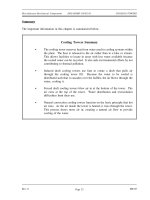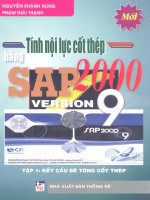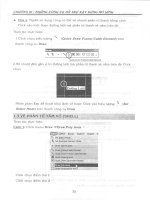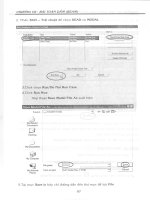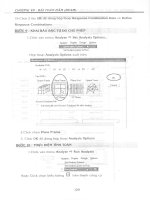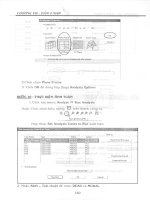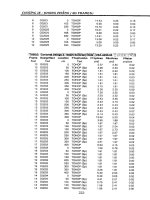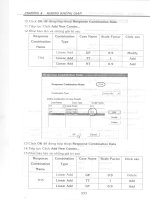Iec 60728 9 2000
Bạn đang xem bản rút gọn của tài liệu. Xem và tải ngay bản đầy đủ của tài liệu tại đây (513.42 KB, 56 trang )
INTERNATIONAL
STANDARD
IEC
60728-9
First edition
2000-11
Part 9:
Interfaces of cabled distribution systems
for digitally modulated signals
Systèmes de distribution par câbles destinés
aux signaux de radiodiffusion sonore et de télévision –
Partie 9:
Interfaces des systèmes de distribution par câbles utilisant
des signaux modulés numériques
Reference number
IEC 60728-9:2000(E)
LICENSED TO MECON Limited. - RANCHI/BANGALORE
FOR INTERNAL USE AT THIS LOCATION ONLY, SUPPLIED BY BOOK SUPPLY BUREAU.
Cabled distribution systems for television
and sound signals –
Publication numbering
As from 1 January 1997 all IEC publications are issued with a designation in the
60000 series. For example, IEC 34-1 is now referred to as IEC 60034-1.
Consolidated editions
The IEC is now publishing consolidated versions of its publications. For example,
edition numbers 1.0, 1.1 and 1.2 refer, respectively, to the base publication, the
base publication incorporating amendment 1 and the base publication incorporating
amendments 1 and 2.
The technical content of IEC publications is kept under constant review by the IEC,
thus ensuring that the content reflects current technology. Information relating to
this publication, including its validity, is available in the IEC Catalogue of
publications (see below) in addition to new editions, amendments and corrigenda.
Information on the subjects under consideration and work in progress undertaken
by the technical committee which has prepared this publication, as well as the list
of publications issued, is also available from the following:
•
IEC Web Site (www.iec.ch)
•
Catalogue of IEC publications
The on-line catalogue on the IEC web site (www.iec.ch/catlg-e.htm) enables
you to search by a variety of criteria including text searches, technical
committees and date of publication. On-line information is also available on
recently issued publications, withdrawn and replaced publications, as well as
corrigenda.
•
IEC Just Published
This summary of recently issued publications (www.iec.ch/JP.htm) is also
available by email. Please contact the Customer Service Centre (see below) for
further information.
•
Customer Service Centre
If you have any questions regarding this publication or need further assistance,
please contact the Customer Service Centre:
Email:
Tel:
+41 22 919 02 11
Fax: +41 22 919 03 00
LICENSED TO MECON Limited. - RANCHI/BANGALORE
FOR INTERNAL USE AT THIS LOCATION ONLY, SUPPLIED BY BOOK SUPPLY BUREAU.
Further information on IEC publications
INTERNATIONAL
STANDARD
IEC
60728-9
First edition
2000-11
LICENSED TO MECON Limited. - RANCHI/BANGALORE
FOR INTERNAL USE AT THIS LOCATION ONLY, SUPPLIED BY BOOK SUPPLY BUREAU.
Cabled distribution systems for television
and sound signals –
Part 9:
Interfaces of cabled distribution systems
for digitally modulated signals
Systèmes de distribution par câbles destinés
aux signaux de radiodiffusion sonore et de télévision –
Partie 9:
Interfaces des systèmes de distribution par câbles utilisant
des signaux modulés numériques
IEC 2000 Copyright - all rights reserved
No part of this publication may be reproduced or utilized in any form or by any means, electronic or
mechanical, including photocopying and microfilm, without permission in writing from the publisher.
International Electrotechnical Commission
3, rue de Varembé Geneva, Switzerland
Telefax: +41 22 919 0300
e-mail:
IEC web site
Commission Electrotechnique Internationale
International Electrotechnical Commission
PRICE CODE
X
For price, see current catalogue
–2–
60728-9 IEC:2000(E)
CONTENTS
Page
FOREWORD .......................................................................................................................... 3
INTRODUCTION .................................................................................................................... 5
Clause
Scope .............................................................................................................................. 6
2
Normative references ....................................................................................................... 6
3
Terms, definitions and abbreviations ................................................................................ 7
4
3.1 Terms and definitions ............................................................................................. 7
3.2 Abbreviations .......................................................................................................... 9
Interfaces for MPEG-2 data signals ................................................................................ 10
4.1
4.2
4.3
4.4
4.5
Introduction........................................................................................................... 10
4.1.1 Application requirements........................................................................... 10
4.1.2 Interfaces.................................................................................................. 11
4.1.3 Packet length and contents ....................................................................... 11
4.1.4 Compliance ............................................................................................... 12
4.1.5 System integration .................................................................................... 12
Synchronous parallel interface (SPI) ..................................................................... 12
4.2.1 Signal format ............................................................................................ 13
4.2.2 Clock signal .............................................................................................. 14
4.2.3 Electrical characteristics of the interface ................................................... 15
4.2.4 Mechanical details of the connector .......................................................... 16
Synchronous Serial Interface (SSI) ....................................................................... 17
Asynchronous Serial Interface (ASI) ..................................................................... 17
3-Wire Interface (3WI) .......................................................................................... 17
Annex A (normative)
Synchronous Serial Interface (SSI) .................................................... 18
Annex B (normative)
Asynchronous Serial Interface (ASI) .................................................. 28
Annex C (informative)
8B/10B tables .................................................................................. 36
Annex D (informative) Implementation guidelines and clock recovery
from the Synchronous Serial Interface (SSI) ......................................................................... 40
Annex E (informative) Implementation guidelines and deriving clocks
from the MPEG-2 packets for the ASI ................................................................................... 43
Annex F (informative) Implementation guidelines and specifications
for the 3-Wire Interface (3WI) ............................................................................................... 47
Bibliography ......................................................................................................................... 50
LICENSED TO MECON Limited. - RANCHI/BANGALORE
FOR INTERNAL USE AT THIS LOCATION ONLY, SUPPLIED BY BOOK SUPPLY BUREAU.
1
60728-9 IEC:2000(E)
–3–
INTERNATIONAL ELECTROTECHNICAL COMMISSION
____________
CABLED DISTRIBUTION SYSTEMS FOR TELEVISION
AND SOUND SIGNALS –
Part 9: Interfaces of cabled distribution systems
for digitally modulated signals
FOREWORD
2) The formal decisions or agreements of the IEC on technical matters express, as nearly as possible, an
international consensus of opinion on the relevant subjects since each technical committee has representation
from all interested National Committees.
3) The documents produced have the form of recommendations for international use and are published in the form
of standards, technical specifications, technical reports or guides and they are accepted by the National
Committees in that sense.
4) In order to promote international unification, IEC National Committees undertake to apply IEC International
Standards transparently to the maximum extent possible in their national and regional standards. Any
divergence between the IEC Standard and the corresponding national or regional standard shall be clearly
indicated in the latter.
5) The IEC provides no marking procedure to indicate its approval and cannot be rendered responsible for any
equipment declared to be in conformity with one of its standards.
6) Attention is drawn to the possibility that some of the elements of this International Standard may be the subject
of patent rights. The IEC shall not be held responsible for identifying any or all such patent rights.
International Standard IEC 60728-9 has been prepared by subcommittee 100D: Cabled
distribution systems, of IEC technical committee 100: Audio, video and multimedia systems
and equipment.
The text of this standard is based on the following documents:
FDIS
Report on voting
100/158/FDIS
100/180/RVD
Full information on the voting for the approval of this standard can be found in the report on
voting indicated in the above table.
This publication has been drafted in accordance with the ISO/IEC Directives, Part 3.
Annexes A and B form an integral part of this standard.
Annexes C, D, E and F are for information only.
LICENSED TO MECON Limited. - RANCHI/BANGALORE
FOR INTERNAL USE AT THIS LOCATION ONLY, SUPPLIED BY BOOK SUPPLY BUREAU.
1) The IEC (International Electrotechnical Commission) is a worldwide organization for standardization comprising
all national electrotechnical committees (IEC National Committees). The object of the IEC is to promote
international co-operation on all questions concerning standardization in the electrical and electronic fields. To
this end and in addition to other activities, the IEC publishes International Standards. Their preparation is
entrusted to technical committees; any IEC National Committee interested in the subject dealt with may
participate in this preparatory work. International, governmental and non-governmental organizations liaising
with the IEC also participate in this preparation. The IEC collaborates closely with the International
Organization for Standardization (ISO) in accordance with conditions determined by agreement between the
two organizations.
–4–
60728-9 IEC:2000(E)
The committee has decided that the contents of this publication will remain unchanged until 2006.
At this date, the publication will be
•
•
•
•
reconfirmed;
withdrawn;
replaced by a revised edition, or
amended.
A bilingual version of this standard may be issued at a later date.
LICENSED TO MECON Limited. - RANCHI/BANGALORE
FOR INTERNAL USE AT THIS LOCATION ONLY, SUPPLIED BY BOOK SUPPLY BUREAU.
60728-9 IEC:2000(E)
–5–
INTRODUCTION
Standards of the IEC 60728 series deal with cable networks for television signals, sound
signals and interactive services including equipment, systems and installations
–
for headend reception, processing and distribution of television and sound signals and
their associated data signals, and
–
for processing, interfacing and transmitting all kinds of signals for interactive services
using all applicable transmission media.
All kinds of networks like
CATV-networks,
–
MATV-networks and SMATV-networks,
–
individual receiving networks
and all kinds of equipment, systems and installations installed in such networks, are within
the scope of this series.
The extent of this standardization work goes from the antennas, special signal source inputs
to the head-end, or other interface points to the network, up to the system outlet or the
terminal input, where no system outlet exists.
The standardization of any user terminals (i.e. tuners, receivers, decoders, multimedia
terminals, etc.) as well as of any coaxial and optical cables and accessories therefore is
excluded.
LICENSED TO MECON Limited. - RANCHI/BANGALORE
FOR INTERNAL USE AT THIS LOCATION ONLY, SUPPLIED BY BOOK SUPPLY BUREAU.
–
–6–
60728-9 IEC:2000(E)
CABLED DISTRIBUTION SYSTEMS FOR TELEVISION
AND SOUND SIGNALS –
Part 9: Interfaces of cabled distribution systems
for digitally modulated signals
1
Scope
RF interfaces and interfaces to telecom networks are not covered by this standard.
In addition references are made to all other parts of the IEC 60728 series and, in particular,
for RF, video and audio interfaces, to IEC 60728-5.
For connections to telecom networks, special Data Communication Equipment (DCE) is
necessary to adapt the serial or parallel interfaces specified in this document to the bitrates
and transmission formats of the public Plesiochronic Digital Hierarchy (PDH) networks. Other
emerging technologies such as Connectionless Broadband Data Services (CBDS),
Synchronous Digital Hierarchy (SDH), Asynchronous Transfer Mode (ATM), etc. can be used
for transmitting MPEG-2 Transport Streams (TS) between remote locations. ATM is
particularly suitable for providing bandwidth on demand and it allows for high data rates.
2
Normative references
The following normative documents contain provisions which, through reference in this text,
constitute provisions of this part of IEC 60728. For dated references, subsequent
amendments to, or revisions of, any of these publications do not apply. However, parties to
agreements based on this part of IEC 60728 are encouraged to investigate the possibility of
applying the most recent editions of the normative documents indicated below. For undated
references, the latest edition of the normative document referred to applies. Members of IEC
and ISO maintain registers of currently valid International Standards.
IEC 60169-8:1978, Radio-frequency connectors – Part 8: RF coaxial connectors with inner
diameter of outer conductor 6,5 mm (0,256 in) with bayonet lock – Characteristic impedance
50 ohms (type BNC)
IEC 60728 (all parts), Cabled distribution systems for television and sound signals
IEC 60728-5,— Cabled distribution systems for television and sound signals – Part 5: Head-end
equipment 1)
IEC 60728-6,— Cabled distribution systems for television and sound signals – Part 6: Optical
equipment 1)
IEC 60793-2:1998, Optical fibres – Part 2: Product specifications
________
1)
To be published.
LICENSED TO MECON Limited. - RANCHI/BANGALORE
FOR INTERNAL USE AT THIS LOCATION ONLY, SUPPLIED BY BOOK SUPPLY BUREAU.
This part of IEC 60728 describes physical interfaces for the interconnection of signal
processing devices for professional CATV/SMATV headend equipment or for similar systems,
such as in up-link stations. This standard, in particular, specifies the transfer of MPEG-2 data
signals in the standardized transport layer format between devices of different signal
processing functions.
60728-9 IEC:2000(E)
–7–
IEC 60874-14:1993, Connectors for optical fibres and cables – Part 14: Sectional
specification for fibre optic connector – Type SC
ISO/IEC 13818-1:1996, Information technology – Generic coding of moving pictures and
associated audio information – Part 1: Systems
ISO/IEC 13818-9:1996, Information technology – Generic coding of moving pictures and
associated audio information – Part 9: Extension for real time interface for systems decoders
ISO/IEC 14165-111, Information technology – Fibre Channel – Part 1: Physical and signalling
interface (FC-PH) 1)
ISO 2110:1989, Information technology – Data communication – 25-pole DTE/DCE interface
connector and contact number assignments
ITU-T Recommendation G.654:1997, Characteristics of a cut-off shifted single-mode optical
fibre cable (Rev 1)
ITU-T Recommendation G.703:1998, Physical/electrical characteristics of hierarchical digital
interfaces (Rev 1)
ETS 300421:1994, Digital broadcasting for television, sound and data services – Framing
structure, channel coding and modulation for 11/12 GHz satellite services
ETS 300429:1994, Digital broadcasting for television, sound and data services – Framing
structure, channel coding and modulation for cable systems
3
Terms, definitions and abbreviations
3.1
Terms and definitions
For the purposes of this part of IEC 60728, the following definitions apply.
3.1.1
head-end
equipment connected between receiving antennas or other signal sources and the remainder
of the cable distribution system to process the signals to be distributed
NOTE The head-end may, for example, comprise antenna amplifiers, frequency converters, combiners, selectors
and generators.
3.1.2
Satellite Master Antenna Television system (SMATV)
system designed to provide sound and television signals to the households of a building or
group of buildings
NOTE
Two system configurations are defined in ETS 300 473 as follows:
•
SMATV system A, based on transparent transmodulation of QPSK satellite signals into QAM signals to be
distributed to the user;
•
SMATV system B, based on direct distribution of QPSK signals to the user, with two options:
–
SMATV-IF distribution in the satellite IF band (above 950 MHz);
–
SMATV-S distribution in the VHF/UHF band, for example in the extended S-band (230-470 MHz).
________
1)
To be published.
LICENSED TO MECON Limited. - RANCHI/BANGALORE
FOR INTERNAL USE AT THIS LOCATION ONLY, SUPPLIED BY BOOK SUPPLY BUREAU.
ITU-R Recommendation BT.656-4:1994, Interfaces for digital component video signals in
525-line and 625-line television systems operating at the 4:2:2 level of Recommendation
ITU-R BT.601 (Part A)
–8–
60728-9 IEC:2000(E)
3.1.3
biphase mark
line code which ensures DC balance, easy clock recovery and polarity freedom
3.1.4
transport stream
includes one or more programs with one or more independent time bases into a single
stream. The transport stream is designed for use in environments where errors are likely,
such as storage or transmission in lossy or noisy media
3.1.6
DVALID
signal which indicates in the 204-byte mode of a Transport Stream that the empty space is
filled with dummy bytes
3.1.7
PSYNC
flag which indicates the beginning of a packet
LICENSED TO MECON Limited. - RANCHI/BANGALORE
FOR INTERNAL USE AT THIS LOCATION ONLY, SUPPLIED BY BOOK SUPPLY BUREAU.
3.1.5
transport packet
packetized element of the transport stream. The packets are either 188 bytes or, in the case
where Reed Solomon FEC is used, 204 bytes in length
60728-9 IEC:2000(E)
3.2
–9–
Abbreviations
eight-to-ten bit conversion
Accumulated Phase
Accumulated Time
Asynchronous Serial Interface
Asynchronous Serial Interface on coaxial cable
Asynchronous Serial Interface on optical fibre
Asynchronous Transfer Mode
Bit Error Rate
Connectionless Broadband Data Services
Distributed Feedback
Deterministic Jitter
data valid
Digital Video Broadcast
European Norm
Fibre Channel
First In First Out
Forward Error Correction
Full Width Half Max
International Electrotechnical Commission
International Organization for Standardization
International Telecommunication Union – Radiocommunication
International Telecommunication Union – Telecommunication
Low-Voltage Differential Signalling
Moving Picture Experts Group
Most Significant Bit
Multiplex
not applicable
Non-Return-to-Zero
Plesiosynchronic Digital Hierarchy
Phase Lock Loop
Physical Medium Dependent
Packet Synchron
Quadrature Amplitude Modulation
Quarternary Phase Shift Keying
Running Disparity
Relative Intrinsic Noise
Random Jitter
Reed Solomon
Synchronous Digital Hierarchy
Society of Motion Picture and Television Engineers
Synchronous Parallel Interface
Synchronous Serial Interface
Synchronous Serial Interface on coaxial cable
Synchronous Serial Interface on optical fibre
Rise-time
Transport Stream
Unified National Coarse Thread
LICENSED TO MECON Limited. - RANCHI/BANGALORE
FOR INTERNAL USE AT THIS LOCATION ONLY, SUPPLIED BY BOOK SUPPLY BUREAU.
8B/10B
ACCP
ACCT
ASI
ASI-C
ASI-O
ATM
BER
CBDS
DFB
DJ
DVALID
DVB
EN
FC
FIFO
FEC
FWHM
IEC
ISO
ITU-R
ITU-T
LVDS
MPEG
MSB
MUX
NA
NRZ
PDH
PLL
PMD
PSYNC
QAM
QPSK
RD
RIN
RJ
RS
SDH
SMPT
SPI
SSI
SSI-C
SSI-O
Tr
TS
UNC
60728-9 IEC:2000(E)
– 10 –
4
Interfaces for MPEG-2 data signals
4.1
Introduction
This subclause describes possible interfaces for devices transmitting or receiving MPEG-2
data as transport packets, such as QPSK demodulators, QAM modulators, multiplexers,
demultiplexers, or telecom network adapters.
This specification is similar to ETS 300429 and ETS 300421.
NOTE Both standards describe a first functional block representing the MPEG2 source coding and multiplexing
as standardized in ISO/IEC 13818-1, a second functional block representing the channel adaptation, whereas an
interface in between shall be based on MPEG2 transport stream specification according to ISO/IEC 13818-1.
Also the case where data signals are transmitted to or from a headend via a telecom network,
or if a headend serves to insert data signals into such networks, is considered to be covered
by the generic channel modulator/demodulator functional block. The interface parameters
valid for this network have to be met. For the latter, reference is made to ITU-T G.703 for
Plesiochronic Digital Hierarchy (PDH) networks.
4.1.1
Application requirements
In order to avoid any unnecessary processing at the transmitting or receiving station of an
interface in certain applications, it is considered an application requirement that the interface
supports 204-byte packet length in such cases, in addition to or instead of the 188-byte
packet length specified in ISO/IEC 13818-1. These two cases are identified in the protocol
diagrams of figures 1 and 2, where also the scope of this specification is delineated. The
relevant associated packet structures are illustrated in figures 3 and 4.
MPEG2 TS packet
(188 bytes)
MPEG2 TS
packet
(188 bytes)
Optional
extra data
(16 bytes)
Conversion to
204-byte packets
Lower protocol
layers
Lower protocol
layers
Transmission medium
Transmission medium
IEC
2181/2000
Figure 1 – Protocol stack for 188-byte packets
NOTE
Shaded areas identify the scope of this standard.
IEC
2182/2000
Figure 2 – Protocol stack for 204-byte packets
LICENSED TO MECON Limited. - RANCHI/BANGALORE
FOR INTERNAL USE AT THIS LOCATION ONLY, SUPPLIED BY BOOK SUPPLY BUREAU.
The function of the channel modulator/demodulator is to adapt the signal to the
characteristics of the transmission channel: satellite, terrestrial or cable as specified in the
DVB base line documents.
60728-9 IEC:2000(E)
1
Sync byte
– 11 –
187 databytes (MPEG2 TS packet)
IEC
2183/2000
IEC
2184/2000
Figure 3 – Packet structure of 188-byte packet
1
Sync byte
187 databytes (MPEG2 TS packet) plus 16 extra
bytes
Figure 4 – Packet structure of 204-byte packet
Interfaces
Three interfaces and two serial transmission media are specified as follows:
•
SPI
(Synchronous Parallel Interface);
•
SSI-C
(Synchronous Serial Interface on coaxial cable);
•
SSI-O
(Synchronous Serial Interface on optical fibre);
•
ASI-C
(Asynchronous Serial Interface on coaxial cable);
•
ASI-O
(Asynchronous Serial Interface on optical fibre).
Each of these interfaces feature a BER such that FEC is not required for reliable data
transport.
The synchronous parallel interface is specified to cover short or medium distances, i.e. for devices
arranged near each other. Subclause 4.2 describes the definitions for such a parallel interface
derived from ITU-R Recommendation BT.656-4. Flags are provided to distinguish 188-byte packets
from 204-byte packets and to signal the existence of valid RS bytes. Note that the interface, as
such, is transparent to the RS bytes.
The synchronous serial interface (SSI) which can be seen as an extension of the parallel
interface, is briefly introduced in 4.3 and described in detail in annexes A and D. The packet
length and the existence of valid RS bytes are conveyed through suitable coding
mechanisms.
Subclause 4.4 introduces the Asynchronous Serial Interface (ASI). Details of the ASI are
provided in annexes B and E. The ASI is configurable to either convey 188-byte packets
(which is mandatory) or optionally 204-byte packets.
4.1.3
Packet length and contents
Each of the interface specifications can be used to convey either 188-byte packets or
204-byte packets in order to enable selection of the appropriate interface characteristics
dependent on the kind of equipment to be interconnected. Mandatory and optional packet
sizes are specified in table 1.
LICENSED TO MECON Limited. - RANCHI/BANGALORE
FOR INTERNAL USE AT THIS LOCATION ONLY, SUPPLIED BY BOOK SUPPLY BUREAU.
4.1.2
60728-9 IEC:2000(E)
– 12 –
Table 1 – Mandatory and optional packet lengths
Data packet carrying capability
Interface
SPI
SSI
ASI
188 bytes
204 bytes
(with 16 dummy bytes)
204 bytes
(with 16 RS bytes)
transmitter
O
M
O
receiver
M
M
M
transmitter
O
M
O
receiver
M
M
M
transmitter
M
O
O
receiver
M
O
O
M = mandatory
O = optional
4.1.4
Compliance
For an equipment to be compliant to this standard it is sufficient for the equipment to show at
least one instance of at least one of the interface specifications as described in 4.1.2 and
specified in detail in subsequent subclauses of this standard, while at least the mandatory
packet sizes as indicated in 4.1.3 shall be supported.
4.1.5
System integration
The interfaces specified in this standard define physical connections between various pieces
of equipment. It is important to notice that various parameters which are important for
interoperation are not specified in this standard. This is intentional as it leaves maximum
implementation flexibility for different applications. In order to facilitate system integration,
equipment suppliers shall provide the following information about the characteristics of the
interfaces in their equipment:
•
interface type (SPI, SSI-C, SSI-O, ASI-C, ASI-O);
•
supported packet length (188 bytes, 204 bytes, both);
•
maximum input jitter (jitter measured as specified in ISO/IEC 13818-9);
•
output jitter (jitter measured as specified in ISO/IEC 13818-9);
•
minimum input data rate (rate measured as specified in ISO/IEC 13818-1);
•
maximum input data rate (rate measured as specified in ISO/IEC 13818-1).
Some of these parameters may not be applicable to certain types of equipment. If all relevant
parameters are provided by equipment suppliers, the proper functioning of the complete
system can be ensured.
4.2
Synchronous parallel interface (SPI)
This subclause describes an interface for a system for parallel transmission of variable data rates.
The data transfer is synchronized to the byte clock of the data stream, which is the MPEG
Transport Stream. Transmission links use LVDS technology [2]1) and 25-pin connections.
________
1)
Figures in brackets refer to items in the bibliography.
LICENSED TO MECON Limited. - RANCHI/BANGALORE
FOR INTERNAL USE AT THIS LOCATION ONLY, SUPPLIED BY BOOK SUPPLY BUREAU.
In case the data stream is packetized in 188-byte packets and the interface is configured to
convey 204-byte packets, the extra packet length can be used for additional data. The
contents of the 16 bytes in this extra packet length are not specified in this standard. One
application could be the transmission of 16 RS bytes associated with the preceding transport
package.
60728-9 IEC:2000(E)
– 13 –
Clock
1
Data (0-7)
8
DVALID
1
PSYNC
1
TX
RX
IEC
2185/2000
The data to be transmitted are MPEG-2 Transport Packets with 188 or 204 bytes. In the case
of the 204-byte packet format, packets may contain a 16-byte "empty space"; a DVALID
signal serves to identify these dummy bytes. A PSYNC flag labels the beginning of a packet.
The data are synchronized to the clock depending on the transmission rate.
Equipment which implements the parallel interface shall support the three transmission
formats as shown in figures 6, 7 and 8.
4.2.1
Signal format
The clock, data, and synchronization signals shall be transmitted in parallel: 8 data bits
together with one (MPEG-2) PSYNC signal and a DVALID signal which indicates in the
204-byte mode that the empty space is filled with dummy bytes. All signals are synchronous
to the clock signal. The signals are coded in NRZ form.
Clock
187
sync
1
2
186
187
sync
1
Data (0-7)
DVALID
PSYNC
IEC
2186/2000
Figure 6 – Transmission format with 188-byte packets
Clock
16
sync
1
2
186
187
1
2
16
sync
1
Data (0-7)
DVALID
PSYNC
IEC
Figure 7 – Transmission format with 204-byte packets
(188 data bytes and 16 dummy bytes)
2187/2000
LICENSED TO MECON Limited. - RANCHI/BANGALORE
FOR INTERNAL USE AT THIS LOCATION ONLY, SUPPLIED BY BOOK SUPPLY BUREAU.
Figure 5 – System for parallel transmission
60728-9 IEC:2000(E)
– 14 –
Clock
203
sync
1
2
201
202
203
sync
1
Data (0-7)
DVALID
PSYNC
IEC
2188/2000
Figure 8 – Transmission format with RS-coded packets (204 bytes) as specified in ETS 300 421
(188 data bytes and 16 valid extra bytes)
Transport packet data word (8 bit: Data 0 to Data 7). Data 7 is the Most
Significant Bit (MSB).
DVALID:
active logic "1". Indicates valid data at the interface. It is constantly high in the
188-byte mode. In the 204-byte mode a low logical state indicates not to check
the extra (dummy) bytes.
PSYNC:
active logic "1". Indicates the beginning of a Transport Packet by signalling the
sync byte.
4.2.2
Clock signal
The clock is a square wave signal where the 0-1 transition represents the data transfer time.
The clock frequency f p depends on the transmission rate.
•
The Transport Packets are transmitted without insertion of additional bytes for RS coding
or padding (packet length 188 bytes):
fp = f u / 8
•
The Transport Packets are transmitted with insertion of additional bytes for RS coding or
padding (packet length 204 bytes):
f p = (204 / 188) × f u / 8
The frequency f u corresponds to the useful bitrate R u of the MPEG-2 transport layer. The
clock frequency f p shall not exceed 13,5 MHz.
Timing reference for data and clock
Data
td
Clock
t
T
IEC
Figure 9 – Clock to data timing (at source)
2189/2000
LICENSED TO MECON Limited. - RANCHI/BANGALORE
FOR INTERNAL USE AT THIS LOCATION ONLY, SUPPLIED BY BOOK SUPPLY BUREAU.
Data (0-7):
60728-9 IEC:2000(E)
– 15 –
1
fp
Clock period:
T =
Clock pulse width:
t =
Data hold time:
td =
4.2.3
T
T
±
2
10
T
T
±
2
10
Electrical characteristics of the interface
a) Logic convention
The terminal A of the line driver is positive with respect to the terminal B for a binary 1
and negative for a binary 0 (see figure 10).
Destination
Source
A
Line
driver
A'
Zt =
Line
100 Ω receiver
Transmission line
B
B'
IEC
2190/2000
Figure 10 – Line-driver and line-receiver interconnection
b) Line-driver characteristics (source)
Output impedance:
100 Ω maximum
Common mode voltage:
1,125 V to 1,375 V
Signal amplitude:
247 mV to 454 mV
Rise and fall times:
less than T / 7, measured between the 20 % and 80 % amplitude points, with a 100 Ω resistive load. The difference between
rise and fall times shall not exceed T / 20.
c) Line receiver characteristics (destination)
Input impedance:
90 Ω to 132 Ω
Maximum input signal:
2,0 V peak-to-peak
Minimum input signal:
100 mV peak-to-peak
However, the line receiver shall sense correctly the binary data when a random data signal
produces the conditions represented by the eye diagram in figure 11 at the data detection point.
LICENSED TO MECON Limited. - RANCHI/BANGALORE
FOR INTERNAL USE AT THIS LOCATION ONLY, SUPPLIED BY BOOK SUPPLY BUREAU.
The interface employs 11 line drivers and 11 line receivers. Each line driver (source) has a
balanced output and the corresponding line receiver (destination) a balanced input
(see figure 10). The line driver and receiver shall be LVDS-compatible, i.e. they shall permit
the use of LVDS for their drivers or receivers. All digital signal time intervals are measured
between the half-amplitude points.
60728-9 IEC:2000(E)
– 16 –
Maximum common mode signal: ±0,5 V, comprising interference in the range of 0 - 15 kHz
(both terminals to ground).
Differential delay: Data shall be correctly sensed when the clock-to-data differential delay is
in the range between ± T /3 (see figure 11).
Reference transition of clock
Umin.
Tmin.
IEC
T min = T / 3,
2191/2000
U min = 100 mV
Figure 11 – Idealized eye diagram corresponding to the minimum input signal level
4.2.4
Mechanical details of the connector
The interface uses the 25-contact type D subminiature connector specified in ISO 2110 with
the contact assignment shown in table 2.
Connectors are locked together with a screw lock, with male screws on the cable connector
and female threaded posts on the equipment connector. The threads are of type UNC 4-40[3].
Cable connectors employ pin contacts and equipment connectors employ socket contacts.
Shielding of the interconnecting cable and its connectors shall be employed.
Table 2 – Contact assignment of 25-contact type D subminiature connector (ISO 2110)
Pin
Signal line
Pin
Signal line
1
Clock A
14
Clock B
2
System gnd
15
System gnd
3
Data 7 A(MSB)
16
Data 7 B
4
Data 6 A
17
Data 6 B
5
Data 5 A
18
Data 5 B
6
Data 4 A
19
Data 4 B
7
Data 3 A
20
Data 3 B
8
Data 2 A
21
Data 2 B
9
Data 1 A
22
Data 1 B
10
Data 0 A
23
Data 0 B
11
DVALID A
24
DVALID B
12
PSYNC A
25
PSYNC B
13
Cable shield
LICENSED TO MECON Limited. - RANCHI/BANGALORE
FOR INTERNAL USE AT THIS LOCATION ONLY, SUPPLIED BY BOOK SUPPLY BUREAU.
Tmin.
60728-9 IEC:2000(E)
4.3
– 17 –
Synchronous Serial Interface (SSI)
The Synchronous Serial Interface (SSI) can be seen as the extension of the parallel interface
by means of an adaptation of the parallel format. SSI is synchronous to the Transport Stream
which is transmitted on the serial link.
A detailed specification of the SSI is provided in annex A and guidelines for its implementation are provided in annex D.
4.4
Asynchronous Serial Interface (ASI)
The Asynchronous Serial Interface (ASI) is a serial link operating at a fixed line clock rate.
4.5
3-Wire Interface (3WI)
The 3-Wire Interface (3WI) can be used for either a Single Program Transport Stream (SPTS)
or a Multi-Program Transport Stream (MPTS).
A detailed specification of 3WI and guidelines for its implementation are provided in annex F.
LICENSED TO MECON Limited. - RANCHI/BANGALORE
FOR INTERNAL USE AT THIS LOCATION ONLY, SUPPLIED BY BOOK SUPPLY BUREAU.
A detailed specification of ASI is provided in annex B and guidelines for its implementation
are provided in annex E.
60728-9 IEC:2000(E)
– 18 –
Annex A
(normative)
Synchronous Serial Interface (SSI)
This annex describes a system for serial encoded transmission of different data rates, with a
transmission rate equal to the data rate. It is based on a layered structure of MPEG-2
Transport Packets as a top layer (Layer-2), and a pair of bottom layers attached to physical
and coding aspects (Layer-0 and Layer-1).
As an example, consider a signal which passes through several re-broadcast steps, such as
the one depicted in figure A.1. In this chain, the last clock (that of the QAM modulator) is
slaved to the encoder/mux clock via four steps of clock regeneration circuits.
Mux
Mux
Remux
PDH
SDH
Network
adapter
QAM
QPSK
mod
QPSK
demod
QAM
Remux
Interfaces points
IEC
Figure A.1 – Example of cascaded interfaces
2192/2000
LICENSED TO MECON Limited. - RANCHI/BANGALORE
FOR INTERNAL USE AT THIS LOCATION ONLY, SUPPLIED BY BOOK SUPPLY BUREAU.
The SSI is based on a line rate directly locked to the transport rate. The SSI is functionally
equivalent to the parallel interface, since the Transport Packets can either be transmitted
contiguously or separated by 16 bytes reserved for dummy bytes or extra bytes. Because the
link and the TS are synchronous, the bit justification operation is not needed. The system
shall be designed to fulfil the high stability requirements of the modulator clocks, even when
several links are cascaded.
